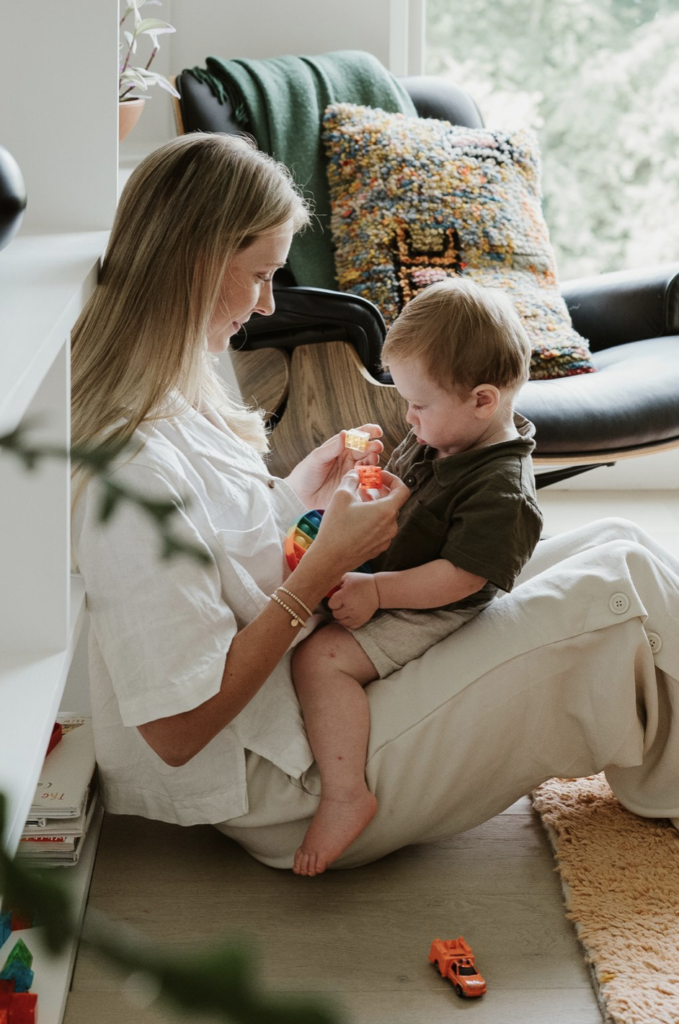Motherhood.
WRITTEN BY DR. GABBY GOLDACH
IMAGES BY COLLEEN MURTHA FOR THE INSIDE SPACE
So, congratulations—you’ve made it!
You successfully grew a human inside your belly. Starting from a meager duo of cells into two trillion—complete with a skull, ten toes, ten fingers (sometimes an extra thumb if differentiation didn’t quite go as planned, but hey, we love them just the same), a beating heart, a central nervous system, and a soul that will soon be ready to take on the world.
Whether you just gave birth at home, in a hospital, or squatting in a jungle, there will be the moment in which you will hold your baby close for the very first time and it may feel like the world around you stops. Comes to a complete halt. Nothing else matters. Your world is in your arms, skin on skin, potentially trying to do a breast crawl, looking for the boob, looking for regulation.
So if you’ve been hanging around this crew for a while now, you will recall that, almost inarguably, the most important system in the body, the nervous system, is the ringmaster of this circus we call living. Our nervous system controls everything in our entire body and has the added job of perceiving our entire world, both within and without.

So let’s face it—after birth, our culture pays the bulk of homage to baby.
We build a registry of gifts for baby, often jam packed with things for him or her to “grow into”.
We create the nursery of this new earthling’s dreams (I’m sure he or she will remember vividly).
We stock up on diapers, formula, and burp cloths.
We purchase expensive strollers that, well, let’s face it, run only slightly smoother than a Radio Flyer wagon that us 90s kids used to tote anything from our siblings to our stuffed animals down the driveway and back.
We buy (or borrow) baby clothes, with hopes to showcase baby’s blossoming personality.
And all of these things are great. And (partially) necessary.
But what are we doing to support mom?
What are we doing to support the death of the woman she once was and has known herself to be, and the birth of the newborn mother.
The birth of the nurturer. The forever caretaker. The ever-kisser of goodnights and boo-boos.
The one who just gave her body to grow a human life for forty weeks. And the one who will continue to give and beat herself up mentally and emotionally if, for some reason, the natural nurturing that is breastfeeding cannot continue as envisioned.
The one who will always be called first to soothe, no matter how amazing and picturesque and present dad is.
The one who can do the one thing she didn’t think possible to do—birth her baby and bring him or her safely and vitally into this world.
Are we getting the picture?

As a society, our support for mother’s is lacking. And we can do better.
Cultures throughout this bountiful and abundant mother earth have evolved greatly over the last several thousand years. However, there are several that have maintained some absolutely ravishing traditions around childbirth and the immediate postpartum period that follows.
In the Malay culture, an Austronesian ethnic group native to much of Southeast Asia and and surrounding islands, it is simply known that a 40-day confinement period will take place after baby is born. This is to say that mom and baby literally do not leave home for forty days after birth, with the exception of emergencies or some sort of extenuating circumstance. Family, friends, community gather to bring mom and baby whatever is necessary. Old Aunties come to give womb massages to mom to support her in her body’s natural healing and recovery from bringing a child into the world (research has shown that it actually takes three years for a woman’s body to fully recover from pregnancy and birth—and no, we are not talking about “bouncing back”). There are deliberate meal plans and diets prepared by the community to facilitate milk production and red blood cell replenishment that are prepared and brought in for consumption. Mama’s diet will consist, almost exclusively, of very specific foods with very intentional ingredients that are tasked with the feat of assisting in this massive healing process.
The Chinese do the same, with their custom being referred to as “sitting the month”.
In India, this moment is referred to as “jaappa”. In Pakistan, “sawa mahina”, translating to “five weeks”.
Same in Korea. In Thailand. In Latin America.
This moment of pause, restoration, and connection is oh so important.
Because the healing isn’t just critical physically. Healing is imperative on a mental, emotional, chemical, and spiritual level, too.
This is the moment in which this newborn mother gets to learn what she is capable of.
This is the moment in which she relinquishes an old self, embracing a self of profound love and responsibility.
This is the moment in which there may be a shift in mama’s view of the world—one that was previously viewed as safe and navigable now may seem dangerous and vulnerable. There is a life that she is responsible for—one that she loves with a love she may not have known could exist. Safety is priority in a way it never has before.
So how can we get to a place of serenity from here?
Cue our nervous system ditty from several paragraphs above.
In these early moments, everything may seem overwhelming. This is when mama’s nervous system is shifting into a state of alert and defense, in full on, primitive, mama bear mode. And this is a great place to be…momentarily. But that deep, profound, rhythmic bond between mama and baby happens when both parties feel at peace. When they are regulated and regulating.
So let’s chat about regulation.
What does it even mean to regulate?
Regulation equates to a homeostatic state—one of rest, recuperation, learning, connection, and harmony.
It is critical that baby has someone to look to for regulation, as the world deep within the dark, safe, quiet, cozy confines of mom is no more. This outside world can be bright, unpredictable, loud, and novel in every way. Baby needs guidance and reassurance that he or she is safe in the current environment. And this is where (sorry papas) mom’s ability to regulate comes in.
The mother-baby dyad learns to dance in the rhythms of one another, sometimes with grace and ease, other times with two left feet and incoordination.
When it works, it really works.
Take breastfeeding, for example.
When mom and baby are in sync, milk flows plentifully. Baby latches gently, yet with power and intention. There is a signaling of a feed-forward loop that signals mom’s hormones to travel where needed, cuing for further milk production. If mom’s body senses that baby is sick, she can, damn near magically, increase the level of immune-boosting cells called leukocytes, without so much as batting an eye. All of this is done through the harmonious dance that is regulation.
Another way we can regulate is through our moods, as mamas.

Gabor Maté, a Budapest-born physician and author, has made a name for himself in the world of child development and adaptation. Born in 1944 in the wake of the Holocaust, his mother took him to the doctor, reporting that her baby would not stop crying. The doctor looked at her solemnly and said “all of my Jewish babies are crying”.
As he grew, his research and development, stress, and regulation took off.
He essentially found that there is a far more profound connection between mother and child than had previously been uncovered. While the mothers of these Jewish babies may have been physically fulfilling their motherly duties, their emotions played an undeniable role in the moods and nervous systems of their children.
The beautiful thing is that this can go both ways.
When we are able to maintain a calm and grounded demeanor, this will impact baby.
When we hold a primary state of dis-harmony and imbalance, baby feels this, too.
So now that we have these examples, the question is, of course, how can we regulate ourselves as mothers? How can we give ourselves more bandwidth in the most world-upturning moment of life?
How can we soften with ourselves, into these new bodies that may feel unrecognizable at moments, yet may contrastingly, bring us such awe and wonder towards the insurmountable feat for which they allowed?
In my world, one way I encourage mamas to do this is through chiropractic. Recall that chiropractic works with the nervous system. To shift out of a state of imbalance and dis-ease and chaos and into one of safety, peace, and “ahhhh”.
However, there are many ways we can do this. But I would like to invite in the thought that the awareness of a need for regulation is what must come first and foremost. From here, we can start to understand the language of our bodies, physically, chemically, mentally, emotionally, and spiritually, so we can gain clarity as to when there is a need for deeper regulation of the nervous system.
So this dance that we’ve done in this piece, I hope, carries a rhythm of hope. A tune of compassion. One that, perhaps, will give you deeper understanding into yourself and why you’re feeling what you’re feeling, in addition to a knowing that you’re not alone. You are never alone.
There is validation and reason and logic and science. And there is also hope. So, so, so much hope.
***
EXPLORE THE INSIDE SPACE
Instagram: @theinsidespace_
Website: the-insidespace.com
Book Appointment: here
Collective Profile: https://consciouscommunitycollectives.com/members/theinsidespace/



